Scientists have spotted an enormous, ‘alien’ comet streaking straight towards the sun.
The 3.7 mile-wide (6 kilometers) space iceball, called 96P/Machholz 1, is thought to have come from somewhere outside our solar system, and is being monitored by the European Space Agency’s (ESA) Solar and Heliospheric Observatory (SOHO) spacecraft as it zips toward our star inside the orbit of Mercury, leaving an icy trail in its wake.
Comet tails are primarily composed of gas, which trickles behind the frozen clumps of ice and gas as they are heated by the sun’s radiation. In 2008, an analysis of the material shed by 150 comets found that 96P/Machholz 1 contained less than 1.5% of the expected levels of the chemical cyanogen, while also being low in carbon — leading astronomers to conclude that it could be an interloper from another solar system. Now, its plunge toward the sun might reveal even more of its secrets.
“96P is a very atypical comet, both in composition and in behavior, so we never know exactly what we might see,” Karl Battams, an astrophysicist at the Naval Research Lab in Washington DC, told spaceweather.com. “Hopefully we can get some beautiful science out of this and share [it] with everyone as soon as we can.”
David Machholz first spotted the eponymous comet in 1986 using a homemade cardboard telescope. Most comets that fall towards the sun tend to be smaller than 32 feet (10 meters) wide, and consequently get burned up as they approach our star.
more at livescience.com
Ask me anything
Explore related questions





